[English] 日本語
 Yorodumi
Yorodumi- PDB-6ssk: Human endogenous retrovirus (HML2) mature capsid assembly, D5 capsule -
+ Open data
Open data
- Basic information
Basic information
| Entry | Database: PDB / ID: 6ssk | ||||||||||||
|---|---|---|---|---|---|---|---|---|---|---|---|---|---|
| Title | Human endogenous retrovirus (HML2) mature capsid assembly, D5 capsule | ||||||||||||
 Components Components | Endogenous retrovirus group K member 24 Gag polyprotein | ||||||||||||
 Keywords Keywords |  VIRAL PROTEIN / Mature retrovirus capsid assembly VIRAL PROTEIN / Mature retrovirus capsid assembly | ||||||||||||
| Function / homology |  Function and homology information Function and homology informationviral process /  nucleic acid binding / structural molecule activity / zinc ion binding / nucleic acid binding / structural molecule activity / zinc ion binding /  plasma membrane plasma membraneSimilarity search - Function | ||||||||||||
| Biological species |   Homo sapiens (human) Homo sapiens (human) | ||||||||||||
| Method |  ELECTRON MICROSCOPY / ELECTRON MICROSCOPY /  single particle reconstruction / single particle reconstruction /  cryo EM / Resolution: 3.18 Å cryo EM / Resolution: 3.18 Å | ||||||||||||
 Authors Authors | Acton, O.J.H. / Taylor, I.A. / Rosenthal, P.B. | ||||||||||||
| Funding support |  United Kingdom, 3items United Kingdom, 3items
| ||||||||||||
 Citation Citation |  Journal: Nat Commun / Year: 2019 Journal: Nat Commun / Year: 2019Title: Structural basis for Fullerene geometry in a human endogenous retrovirus capsid. Authors: Oliver Acton / Tim Grant / Giuseppe Nicastro / Neil J Ball / David C Goldstone / Laura E Robertson / Kasim Sader / Andrea Nans / Andres Ramos / Jonathan P Stoye / Ian A Taylor / Peter B Rosenthal /     Abstract: The HML2 (HERV-K) group constitutes the most recently acquired family of human endogenous retroviruses, with many proviruses less than one million years old. Many maintain intact open reading frames ...The HML2 (HERV-K) group constitutes the most recently acquired family of human endogenous retroviruses, with many proviruses less than one million years old. Many maintain intact open reading frames and provirus expression together with HML2 particle formation are observed in early stage human embryo development and are associated with pluripotency as well as inflammatory disease, cancers and HIV-1 infection. Here, we reconstruct the core structural protein (CA) of an HML2 retrovirus, assemble particles in vitro and employ single particle cryogenic electron microscopy (cryo-EM) to determine structures of four classes of CA Fullerene shell assemblies. These icosahedral and capsular assemblies reveal at high-resolution the molecular interactions that allow CA to form both pentamers and hexamers and show how invariant pentamers and structurally plastic hexamers associate to form the unique polyhedral structures found in retroviral cores. | ||||||||||||
| History |
|
- Structure visualization
Structure visualization
| Movie |
 Movie viewer Movie viewer |
|---|---|
| Structure viewer | Molecule:  Molmil Molmil Jmol/JSmol Jmol/JSmol |
- Downloads & links
Downloads & links
- Download
Download
| PDBx/mmCIF format |  6ssk.cif.gz 6ssk.cif.gz | 336.7 KB | Display |  PDBx/mmCIF format PDBx/mmCIF format |
|---|---|---|---|---|
| PDB format |  pdb6ssk.ent.gz pdb6ssk.ent.gz | 287 KB | Display |  PDB format PDB format |
| PDBx/mmJSON format |  6ssk.json.gz 6ssk.json.gz | Tree view |  PDBx/mmJSON format PDBx/mmJSON format | |
| Others |  Other downloads Other downloads |
-Validation report
| Arichive directory |  https://data.pdbj.org/pub/pdb/validation_reports/ss/6ssk https://data.pdbj.org/pub/pdb/validation_reports/ss/6ssk ftp://data.pdbj.org/pub/pdb/validation_reports/ss/6ssk ftp://data.pdbj.org/pub/pdb/validation_reports/ss/6ssk | HTTPS FTP |
|---|
-Related structure data
| Related structure data |  10296MC 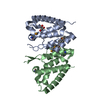 6sa9C 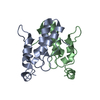 6saiC  6ssjC  6sslC  6ssmC C: citing same article ( M: map data used to model this data |
|---|---|
| Similar structure data |
- Links
Links
- Assembly
Assembly
| Deposited unit | 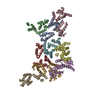
|
|---|---|
| 1 | x 10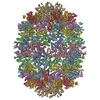
|
- Components
Components
| #1: Protein | Mass: 27570.488 Da / Num. of mol.: 9 Source method: isolated from a genetically manipulated source Source: (gene. exp.)   Homo sapiens (human) / Gene: ERVK-24 / Production host: Homo sapiens (human) / Gene: ERVK-24 / Production host:   Escherichia coli (E. coli) / References: UniProt: P63145 Escherichia coli (E. coli) / References: UniProt: P63145 |
|---|
-Experimental details
-Experiment
| Experiment | Method:  ELECTRON MICROSCOPY ELECTRON MICROSCOPY |
|---|---|
| EM experiment | Aggregation state: PARTICLE / 3D reconstruction method:  single particle reconstruction single particle reconstruction |
- Sample preparation
Sample preparation
| Component | Name: Human endogenous retrovirus (HML2) mature capsid assembly, D5 capsule Type: COMPLEX / Entity ID: all / Source: RECOMBINANT |
|---|---|
| Molecular weight | Value: 2.5 MDa / Experimental value: YES |
| Source (natural) | Organism:   Homo sapiens (human) Homo sapiens (human) |
| Source (recombinant) | Organism:   Escherichia coli (E. coli) Escherichia coli (E. coli) |
| Buffer solution | pH: 8 |
| Specimen | Conc.: 16 mg/ml / Embedding applied: NO / Shadowing applied: NO / Staining applied : NO / Vitrification applied : NO / Vitrification applied : YES : YES |
| Specimen support | Grid material: COPPER / Grid mesh size: 200 divisions/in. / Grid type: Quantifoil R2/2 |
Vitrification | Cryogen name: ETHANE |
- Electron microscopy imaging
Electron microscopy imaging
| Experimental equipment |  Model: Titan Krios / Image courtesy: FEI Company |
|---|---|
| Microscopy | Model: FEI TITAN KRIOS |
| Electron gun | Electron source : :  FIELD EMISSION GUN / Accelerating voltage: 300 kV / Illumination mode: FLOOD BEAM FIELD EMISSION GUN / Accelerating voltage: 300 kV / Illumination mode: FLOOD BEAM |
| Electron lens | Mode: BRIGHT FIELD Bright-field microscopy Bright-field microscopy |
| Specimen holder | Cryogen: NITROGEN / Specimen holder model: FEI TITAN KRIOS AUTOGRID HOLDER |
| Image recording | Average exposure time: 60 sec. / Electron dose: 30 e/Å2 / Detector mode: COUNTING / Film or detector model: FEI FALCON III (4k x 4k) / Num. of grids imaged: 1 / Num. of real images: 10935 |
- Processing
Processing
| Software | Name: PHENIX / Version: 1.14_3260: / Classification: refinement | ||||||||||||||||||||||||||||||||||||||||
|---|---|---|---|---|---|---|---|---|---|---|---|---|---|---|---|---|---|---|---|---|---|---|---|---|---|---|---|---|---|---|---|---|---|---|---|---|---|---|---|---|---|
| EM software |
| ||||||||||||||||||||||||||||||||||||||||
CTF correction | Type: PHASE FLIPPING AND AMPLITUDE CORRECTION | ||||||||||||||||||||||||||||||||||||||||
| Symmetry | Point symmetry : D5 (2x5 fold dihedral : D5 (2x5 fold dihedral ) ) | ||||||||||||||||||||||||||||||||||||||||
3D reconstruction | Resolution: 3.18 Å / Resolution method: FSC 0.143 CUT-OFF / Num. of particles: 93221 / Symmetry type: POINT | ||||||||||||||||||||||||||||||||||||||||
| Atomic model building | B value: 90 / Protocol: OTHER / Space: REAL / Target criteria: map vs model FSC | ||||||||||||||||||||||||||||||||||||||||
| Refine LS restraints |
|
 Movie
Movie Controller
Controller







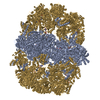

 PDBj
PDBj

